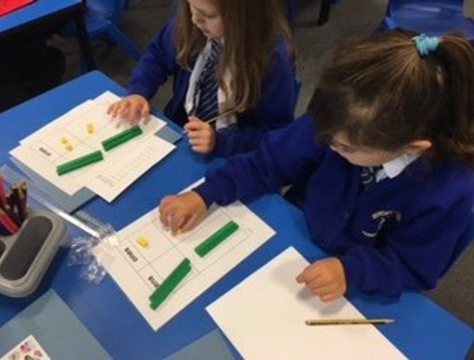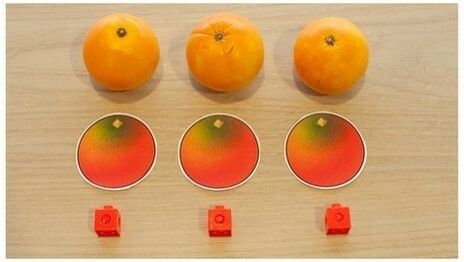Our Curriculum
Maths

Maths Champions 2024-2025
Intent:
At Bewsey Lodge we recognise the importance of mathematics throughout each child’s everyday and future life. It enables children to understand relationships and patterns in both number and space in the world around them. It is essential to everyday life, critical to science, technology and engineering and necessary for financial literacy and most forms of employment. We intend to give each child the self-confidence and resilience to reach their full potential by ensuring that they have the tools to calculate fluently, reason logically, problem solve and think in abstract ways.
Implementation:
At Bewsey Lodge we use the Singapore approach to teaching Mathematics from Early Years to Year 6.
 The Singapore method of teaching mathematics develops pupils’ mathematical skills and confidence without having to resort to memorising procedures to pass tests - making mathematics more engaging and interesting.
The Singapore method of teaching mathematics develops pupils’ mathematical skills and confidence without having to resort to memorising procedures to pass tests - making mathematics more engaging and interesting.
There are many reasons why the Singapore approach has such an impact on teaching and learning but one key factor is its step-by-step approach that can be used at home or in the classroom.
Pupils using base 10 materials to understand place value.
 At Bewsey Lodge we have developed the Singapore system even further by ensuring that children are taught in smaller class groups so that teachers can give extra support or task extension where needed. Regular pupil progress meetings ensure that more able children have their learning extended and carefully planned support is put into place for those finding some concepts difficult. Led by experienced teachers, these interventions ensure that children make a good level of progress.
At Bewsey Lodge we have developed the Singapore system even further by ensuring that children are taught in smaller class groups so that teachers can give extra support or task extension where needed. Regular pupil progress meetings ensure that more able children have their learning extended and carefully planned support is put into place for those finding some concepts difficult. Led by experienced teachers, these interventions ensure that children make a good level of progress.
Pupils using egg boxes to find number bonds to 10.
The rationale:
Young children are happy playing with blocks or drawing pictures. But they can find number symbols, like 5 + 2 = 7, mystifying. The Singapore method begins by allowing children to start learning about maths by playing with real objects, blocks or cut-out pictures.
They build confidence with the basic ideas of adding and taking away. There is then a second stage of drawing pictures representing the objects. And only later do they gradually start to add numbers to their drawings. Number symbols like 5 or 10 as well as symbols like + or - are often difficult for children to understand. And if they are introduced too quickly, there is a risk that young children will struggle and from then on never fully recover their confidence in maths. Failing repeated tests on symbolic sums at school only deepens their anxiety and they soon learn that maths is not for them.
The Singapore method goes more gradually - from handling "concrete" things, to drawing one-to-one "pictorial" iconic representations of them, to eventually understanding and using the mysterious "abstract" symbols with confidence.

All of our teachers have had extensive, bespoke training in this approach, complimented by training (at degree level) in the psychological theories of children's learning. We use 'Maths no problem' resources to accompany our teaching.
“It's better to solve one problem 5 ways, than it is to solve 5 different problems.” Ban Har.
2016 was our first complete year of using this approach in Key stages 1 & 2. whereas within the early years setting a concrete approach has always been used. Nevertheless in 2021, 'Foundations' was introduced to Reception classes - a bespoke Maths No Problem curriculum using story books and pictures.
If you would like to know more about the is approach you can speak to your class teacher, Miss Muia (Maths Co-ordinator) or Mrs Williams..
The first steps...
Children start by counting familiar things using blocks or cut-out pictures they can physically line up in a row. For instance counting pieces of fruit, their own ages, or people in the room. With one block or cut-out picture for each orange, or year, or person.
They can learn most basic maths concepts with these objects. For instance add objects to the row, or take them away, to understand adding and subtraction. Or split a row in the middle to understand halving. Then children start to draw pictures on paper of the things they are counting, with a box around each picture. So there's one box for each thing they are counting. Over time they drop the pictures and just draw the boxes.
Then children start to draw pictures on paper of the things they are counting, with a box around each picture. So there's one box for each thing they are counting. Over time they drop the pictures and just draw the boxes.

Gradually, once they are confident with drawing boxes to count objects, children start to write the number of boxes as a figure above the drawing.
Eventually they no longer need to draw all the boxes. They just draw one long box or bar and label it with the number. This step away from one-to-one representations to symbols is crucial and it may take a year or more for some children to become confident with it. But the benefits later on are worth it.

These are the first steps which from the building blocks of securely understanding number, ready for when things become a bit more tricky!
Impact:
Through termly assessments (past SATs papers and nfer papers), children demonstrate quick recall of facts and procedures. This includes the recollection of the times tables. They have the flexibility and fluidity to move between different contexts and representations of mathematics and the ability to recognise relationships and make connections. Pupils are able to discuss their reasoning, knowing that they can try different ways to approach a mathematical problem.
At the end of their maths journey at Bewsey Lodge, we will ensure that:
Children are happy learners who talk enthusiastically about their learning and are eager to further their progress in maths.
The impact of ‘mastery’ and the emphasis on accurate use of mathematical language is evident during class/pupil discussions.
Children’s fluency in number is evident in our proven track record of above national average results in KS2 SATs.
Children use their mathematical skills to problem solve in their daily lives.
